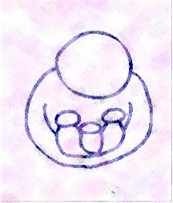
Mothering the Mother Birth Services
numbers@rocketmail.com
|
|
Mothering the Mother Birth Services numbers@rocketmail.com |
by Mary Paliescheskey, Birth Guide
Mothering the Mother Birth Services
Relaxation training during childbirth education class has been shown to significantly reduce self-reported pain and heart rate.2 Childbirth lectures are not able to duplicate the results of actual relaxation training.2 Effective childbirth education classes combine lecture with relaxation training.
Practice integrates the theory of lecture into a couple’s life. Having success instantly in class can lead to a false sense of confidence. True integration requires repeated practice over the weeks of your last trimester. A relaxation technique experienced once in lecture will be forgotten in the increasing intensity of labor.
As you practice, your skill with the techniques will increase. A woman’s confidence in coping with labor increases with practice. With increasing confidence, fear of pain is reduced and a woman feels capable of handling labor. A woman approaching labor with a fear of pain and a sense of helplessness will have a more difficult labor.3 Conversely, a woman confident in relaxation techniques who practiced will have lower levels of pain and greater amount of coping related thought.3
How do you choose a relaxation technique? There are a variety of techniques. Some choices are: 1) Focus on your breath; 2) Gaze at a picture or object; 3) Music; 4) Nature sounds; 5) Count/ patterned breathing; 6) Hold an object; 7) Make sound; 8) Visualize/guided imagery; 9) Imagine touching an object; or 10) Focus on sounds far away from you.
Practice a variety of these techniques. One may seem the strongest to you. However, having experience with many techniques can be useful during labor. You may need to change techniques to keep your focus and concentration.
Begin using your relaxation techniques whenever you feel the need in labor. Your body will tell you when to pay attention to your contractions. Birth partners should reserve the use of patterned breathing for active labor only. Women who use patterned breathing techniques in early labor show significantly higher levels of fatigue.4
In conclusion, couples should practice a variety of relaxation techniques; choose childbirth education classes containing both lecture and relaxation practice; and work at increasing confidence in the birth process.
You have the ability to birth your child. Believe in your inner strength.
References: 1.Janke, J. The effect of relaxation therapy on preterm labor outcomes. J Obstet Gynecol Neonatal Nurs. 1999 May-Jun;28(3):255-63.
2.Geden, E; Beck, NC; Brouder,G; Glaister, J; Pohlman, S. Self-report and psychophysiological effects of Lamaze preparation: an analogue of labor pain. Res Nurs Health. 1985 Jun;8(2):155-65
3.Wuitchik, M; Hesson, K; Bakal, DA. Perinatal predictors of pain and distress during labor. Birth. 1990 Dec;17(4):186-91.
4.Pugh, LC; Milligan, RA; Gray, S; Strickland, OL. First stage management: An examination of patterned breathing and fatique. Birth. 1998 Dec;25(4):241-5.
Return to top
